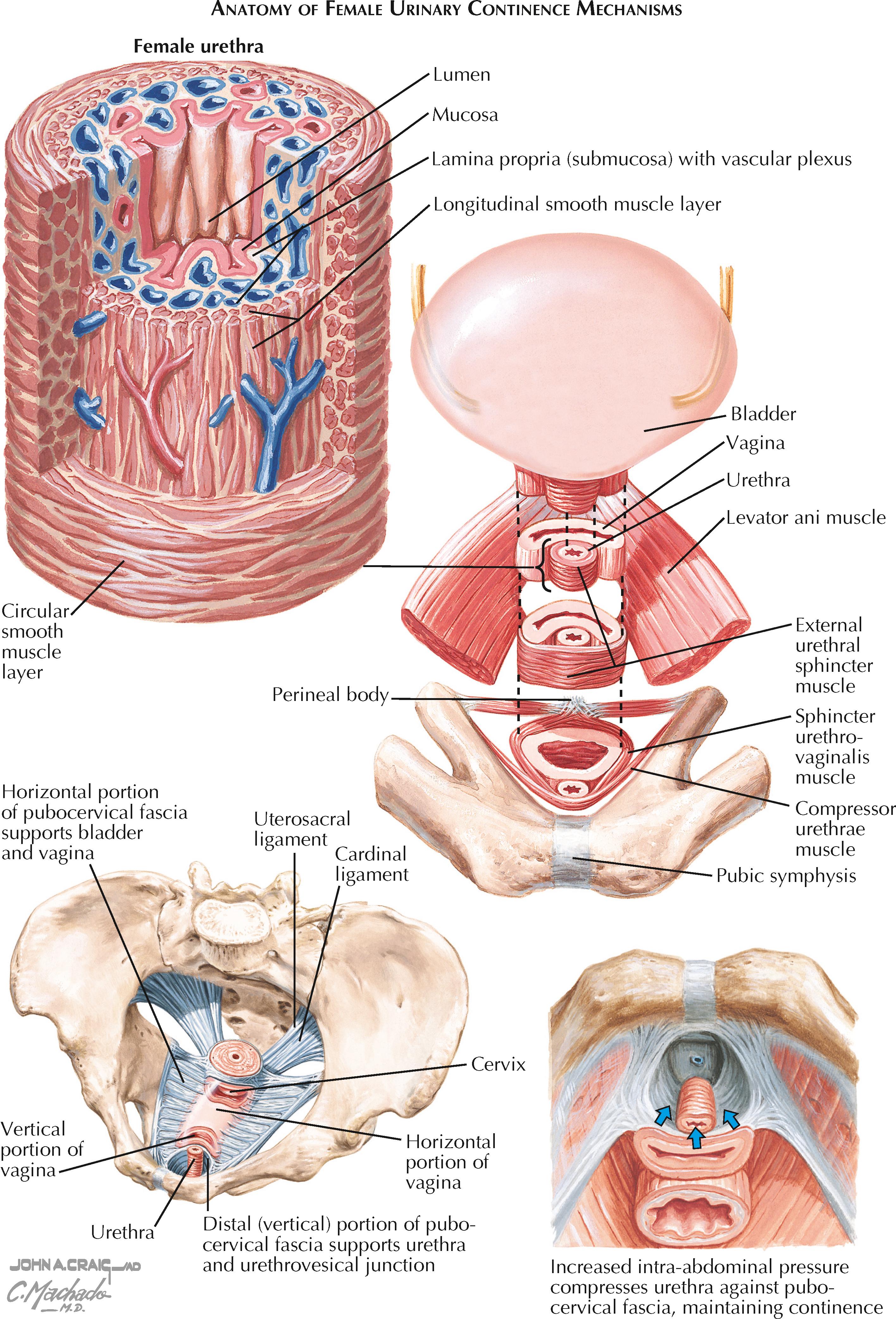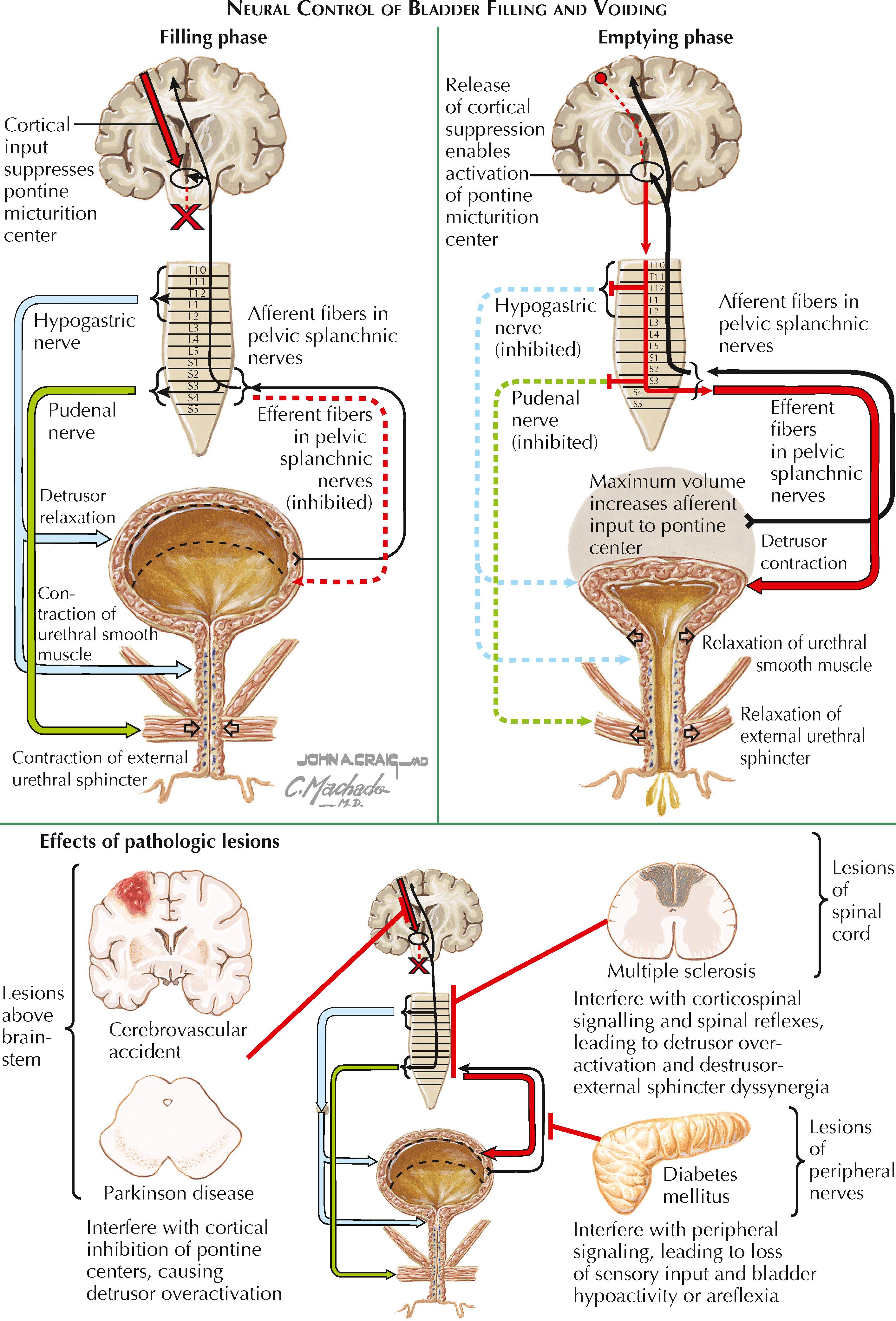Physical Address
304 North Cardinal St.
Dorchester Center, MA 02124
Urinary incontinence affects an estimated 13 million adults in the United States, 85% of whom are women. The problem is especially common among nursing home residents, affecting 50%, and older women, affecting 15% to 30% of women over 65 years old who live in retirement communities. An estimated $15 to $20 billion is spent on this problem each year in the United States alone.
In both sexes, the urethral wall contains smooth muscle cells that constitute an intrinsic urethral sphincter. These cells surround the submucosa and are arranged in an inner longitudinal layer and a thinner outer circular layer.
In males, an internal urethral sphincter is formed by a ring of smooth muscle near the bladder neck, which receives sympathetic input and prevents the retrograde passage of semen during ejaculation.
In both sexes, the urethra is also surrounded by rings of striated muscle that form an external urethral sphincter. In males, this muscle is located around the membranous urethra. In females, it is located primarily around the middle third of the urethra, and it receives fibers from the compressor urethrae and sphincter urethrovaginalis muscles located just above the perineal membrane. The compressor urethrae muscles arise from the ischiopubic rami, with fibers from each side interdigitating anterior to the urethra. Meanwhile, the sphincter urethrovaginalis muscles arise from the perineal body, pass along the lateral walls of the vagina, and then also interdigitate anterior to the urethra.
The pressures exerted by the urethral sphincters alone are sufficient to maintain continence in most circumstances. During acute increases in intraabdominal pressure, however, the proximal urethra requires additional support to resist the resulting increase in intravesical pressure. In females, such support comes from a “hammock” of connective tissue against which the bladder neck and proximal urethra are compressed. The hammock is formed by the pubocervical fascia, which connects to the tendinous arch of the pelvic fascia on each side (which is itself attached to the levator ani muscles).
Both filling and voiding require coordinated action of the detrusor muscle and urethral sphincters. During filling, mild distention of the bladder produces afferent signals that travel in pelvic nerves to the spinal cord. These signals trigger spinal reflexes that increase sympathetic outflow along the hypogastric nerves, causing relaxation of the detrusor muscle and contraction of the ureteral smooth muscle. In addition, these reflexes stimulate neurons originating in Onuf nucleus, located in the sacral spinal cord, which travel along the pudendal nerve to stimulate contraction of the external urethral sphincter. This response, known as the “gua rding reflex,” prevents incontinence during bladder filling.
When bladder distention reaches a set point, intense afferent signals from the bladder activate ascending spinobulbospinal pathways that stimulate the pontine micturition center (PMC, also known as the Barrington nucleus). Activation of the PMC inhibits sympathetic outflow to the bladder and urethra, inhibits pudendal input to the external urethral sphincter, and promotes parasympathetic input to the detrusor along the pelvic splanchnic nerves. The net effect is relaxation of the urethral sphincters followed by contraction of the detrusor, which leads to voiding.

In adults, the PMC can be consciously suppressed until voiding is desired. Such suppression depends on inputs from cortical areas that include the prefrontal cortex, anterior cingulate cortex, and periaqueductal gray. In infants, primitive sacral reflexes promote voiding without the involvement of higher brain areas, such as the PMC. These reflexes eventually become subjected to the control of the PMC and modulatory inputs from the prefrontal cortex.
Voiding dysfunctions reflect abnormalities in either the normal anatomy or neural control of the lower urinary tract. The major causes of chronic voiding dysfunction can be broadly classified as:
Neuropathic dysfunction
Stress urinary incontinence
Urge urinary incontinence
Of note, overflow incontinence often occurs secondary to neuropathic dysfunction or chronic outlet obstruction, and it is thus not considered a primary form of incontinence.
Patients with neuropathic dysfunction have aberrations in the neural control of filling and voiding. Lesions at different levels in the relevant neural pathways cause different symptom patterns. Thus the specific level of the lesion must be inferred as precisely as possible based on history and urodynamic data.
With suprapontine lesions (i.e., cerebrovascular accident, Parkinson disease), cortical inhibition of the PMC is eliminated, causing the detrusor to become overactive. Because spinal cord connections remain intact, however, synergy persists between bladder contraction and urethral sphincter relaxation. In Parkinson disease, however, opening of the striated sphincter may be delayed, which could be misinterpreted as dyssynergia.
With lesions of between the pons and spinal cord segment S2 (i.e., multiple sclerosis, trauma), there is initial areflexia of the bladder, but intrinsic spinal reflexes (typically inactive since infancy) slowly emerge and cause the detrusor to become overactive. The voiding is often inefficient, however, because interruption of spinal circuits can lead to detrusor-external sphincter dyssynergia (DESD).
With lesions of the peripheral pelvic nerves (i.e., diabetes mellitus, pelvic surgery), patients lose afferent sensations from the bladder, and the bladder often becomes hypoactive or even areflexic, leading to urinary retention.
A thorough history, neurologic examination, and urodynamic evaluation (see Plate 8-4 ) often elucidates the specific site of the lesion. The treatment strategy depends on the specific kind of dysfunction.
If the detrusor is overactive, pharmacologic agents are the first-line treatment. Anticholinergic drugs, for example, can block parasympathetic input to the bladder. Oxybutynin is a tertiary amine antimuscarinic drug commonly used for this indication; common adverse effects include dry mouth, facial flushing, dry skin, and drowsiness. Tolterodine tartarate is another common agent that generally has fewer adverse effects than oxybutynin. Additional antimuscarinics include solifenacin, darifenacin, trospium, and fesoterodine. In select patients with refractory detrusor overactivity, a sacral nerve stimulator with an implantable electrode can be placed. In others, injection of botulinum toxin into the detrusor muscle may be helpful.
In cases of urinary retention, clean intermittent catheterization is the mainstay of conservative management. Catheterization every 4 to 6 hours can prevent leakage associated with bladder overflow (i.e., overflow incontinence). An indwelling Foley or suprapubic catheter may be required for patients who do not have the manual dexterity or resources to perform clean intermittent catheterization.

Become a Clinical Tree membership for Full access and enjoy Unlimited articles
If you are a member. Log in here